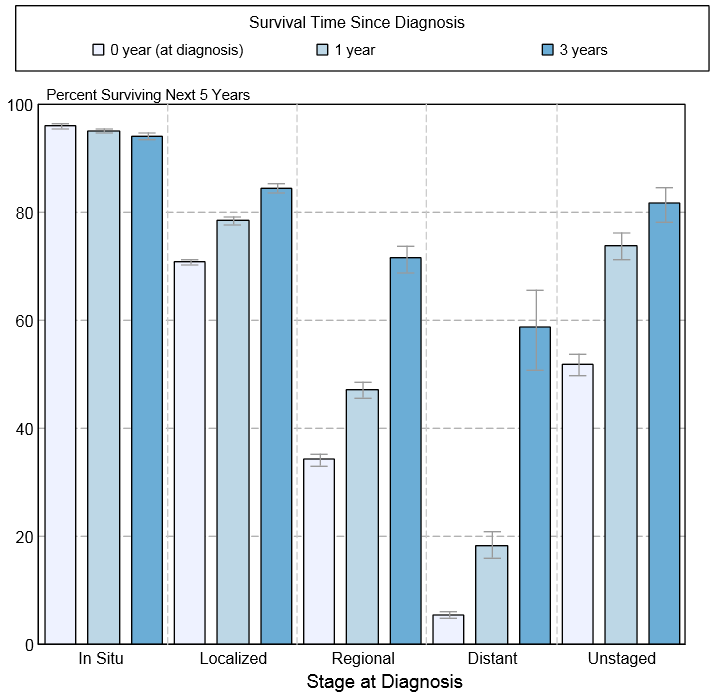Transitional cell carcinoma natural history, complications and prognosis
|
Transitional cell carcinoma Microchapters |
|
Differentiating Transitional cell carcinoma from other Diseases |
|---|
|
Diagnosis |
|
Treatment |
|
Case Studies |
|
Transitional cell carcinoma natural history, complications and prognosis On the Web |
|
American Roentgen Ray Society Images of Transitional cell carcinoma natural history, complications and prognosis |
|
FDA on Transitional cell carcinoma natural history, complications and prognosis |
|
CDC on Transitional cell carcinoma natural history, complications and prognosis |
|
Transitional cell carcinoma natural history, complications and prognosis in the news |
|
Blogs on Transitional cell carcinoma natural history, complications and prognosis |
|
Directions to Hospitals Treating Transitional cell carcinoma |
Editor-In-Chief: C. Michael Gibson, M.S., M.D. [1]
Overview
Natural History
Complications
Bladder cancers may spread into the nearby organs. They may also travel through the pelvic lymph nodes and spread to the liver, lungs, and bones. Additional complications of bladder cancer include:
- Anemia
- Swelling of the ureters(hydronephrosis)
- Urethral stricture
- Urinary incontinence
Prognosis
Transitional cell carcinoma of bladder
- Based on data from 2005-2011, the 5-year survival rate of patients with bladder cancer is approximately 77.4%.[1]
- Between 2004 and 2010, the 5-year relative survival of patients with bladder cancer was 79.1%.[2]
- When stratified by age, the 5-year relative survival of patients with bladder cancer was 83.8% and 74.1% for patients <65 and ≥ 65 years of age respectively.[2]
- The survival of patients with bladder cancer varies with the stage of the disease. Shown below is a table depicting the 5-year relative survival by the stage of bladder cancer:[2]
| Stage | 5-year relative survival (%), (2004-2010) |
| All stages | 77.4% |
| In situ | 96.2% |
| Localized | 69.2% |
| Regional | 33.7% |
| Distant | 5.5% |
| Unstaged | 48.7% |
- Shown below is an image depicting the 5-year conditional relative survival (probability of surviving in the next 5-years given the cohort has already survived 0, 1, 3 years) between 2004 and 2010 of bladder cancer by stage at diagnosis according to SEER. These graphs are adapted from SEER: The Surveillance, Epidemiology, and End Results Program of the National Cancer Institute.[2]
How well a patient with bladder cancer does depends on the initial stage and response to treatment of the bladder cancer.
The outlook for stage 0 or I cancers is fairly good. Although the risk of the cancer returning is high, most bladder cancers that return can be surgically removed and cured. After treatment for bladder cancer, patient should be closely monitored for return of cancer. This may include:
- Bone scans and CT scans to check for the spread or return of cancer
- Monitoring symptoms that might suggest the disease is getting worse, such as fatigue, weight loss, increased pain, decreased bowel and bladder function, and weakness
- Complete blood count (CBC) to monitor for anemia
- Bladder exams every 3 to 6 months after treatment
- Urinalysis if you did not have your bladder removed
The cure rates for people with stage III tumors are less than 50%. Patients with stage IV bladder cancer are rarely cured.
- The major prognostic factor at the time of diagnosis of upper tract transitional cell cancer is the depth of infiltration into or through the uroepithelial wall.
- Most superficial tumors are likely to be well differentiated, while infiltrative tumors are likely to be poorly differentiated.
- The incidence of synchronous or metachronous contralateral upper tract cancers ranges from 2% to 4%; the incidence of subsequent bladder cancer after prior upper tract transitional cell cancer ranges from 30% to 50%.
- When involvement of the upper tract is diffuse (involving both the renal pelvis and ureter), the likelihood of subsequent development of bladder cancer increases to 75%.
- DNA ploidy has not added significant prognostic information beyond that provided by stage and grade.[3]
The prognosis (chance of recovery) depends on the stage and grade of the tumor.[3]
- Depending on the stage and grade of the tumor at the time of diagnosis, the prognosis may vary. However, the 5-year survival rate of patients with upper urinary tract transitional cell carcinoma is approximately 75%.[4]
- They are curable in more than 90% of patients if they are superficial and confined to the renal pelvis or ureter.
- Patients with deeply invasive tumors that are still confined to the renal pelvis or ureter have a 10% to 15% likelihood of cure.
- Patients with tumors with penetration through the urothelial wall or with distant metastases usually cannot be cured with currently available forms of treatment.
References
- ↑ Bladder Cancer. Surveillance, Epidemiology, and End Results Program 2015.http://seer.cancer.gov/statfacts/html/urinb.html
- ↑ 2.0 2.1 2.2 2.3 Howlader N, Noone AM, Krapcho M, Garshell J, Miller D, Altekruse SF, Kosary CL, Yu M, Ruhl J, Tatalovich Z,Mariotto A, Lewis DR, Chen HS, Feuer EJ, Cronin KA (eds). SEER Cancer Statistics Review, 1975-2011, National Cancer Institute. Bethesda, MD, http://seer.cancer.gov/csr/1975_2011/, based on November 2013 SEER data submission, posted to the SEER web site, April 2014.
- ↑ 3.0 3.1 Transitional cell cancer. National cancer institute. http://www.cancer.gov/types/kidney/hp/transitional-cell-treatment-pdq#section/_1
- ↑ Munoz JJ, Ellison LM (2000). "Upper tract urothelial neoplasms: incidence and survival during the last 2 decades". J Urol. 164 (5): 1523–5. PMID 11025695.
